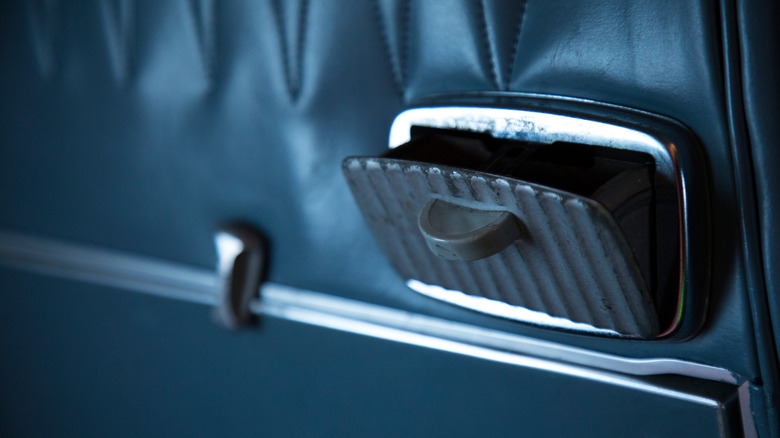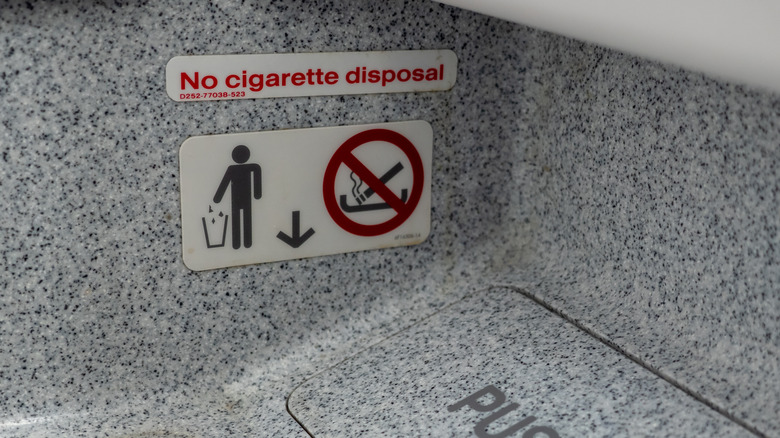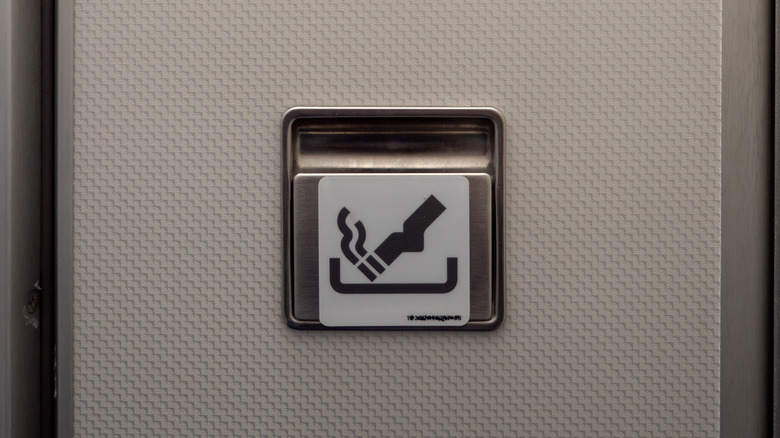The Reason Airplanes Have Ashtrays Even Though Smoking Is Banned
Ah, the Golden Age of air travel. We've all seen the black-and-white pictures, right? Huge leather sofas and spiral staircases leading up to second-floor lounges rather than sardine-can buckets seats with barely enough leg room for humans above 5-foot, 6-inches? Actual silverware and glassware to compliment your pheasant under glass, madame, rather than, let's say, microwaved "chicken cutlet" soaked in Ragu runoff? Baskets of fruit — actual, beautiful fruit from Earth — instead of plastic-wrapped, dry biscuits forged in vats of partially hydrogenated coronary disease? Oh yeah, and the one downside: lots and lots (and lots) of carcinogenic second-hand smoke. So things weren't all great.
Given how strict airlines are nowadays with check-in bag size and weight, security measures like those annoying 100ml bottles, staying buckled in with the tray up during take-off and landing, etc., it might be shocking to remember that smoking was completely okay on flights until roughly the 1970s. It took decades to beat back the airborne smoking crowd and phase out smoking on planes, per Simple Flying. By 2000 nearly all flights worldwide were smoking-free.
And yet, planes continue to come equipped with ashtrays, typically near or on bathroom doors. As Forbes explains, the reason is so simple that we can all appreciate it: people are jerks. At least, there's a possibility that at least one jerk is going to board a flight. And if that person lights up, there's got to be a safe place to discard the butt.
No ifs, ands, or butts
But if ashtrays are still on airplanes despite smoking bans, the reader might ask, wouldn't they just encourage surreptitious smokers to sneak some cigs aboard and skulk away to the toilet like a bathroom-bound high schooler puffing away while chuckling about duping the principal? Possibly. But if folks are going to ignore the rules and be jerks, then the rest of us have no choice but to stay safe.
As Forbes recounts, it's either, a) have an ashtray on board just in case to prevent fire hazards, or, b) put out a cigarette on the smoker's own forehead — or rather, flick it in the garbage can. Airplanes are not the kind of environment where you want to mess with fire hazards any more than you want terrible air circulation throughout the cabin. So, the Federal Aviation Administration (FAA) deems ashtrays "minimum equipment" (a type of fire protection, presumably) along the lines of absolute fundamentals like "fuel," landing gear," "oxygen," and other basics without which a plane simply can't function. And make no mistake, airplane minimum equipment lists are extremely thorough, highly detailed, and take zero chances, which is great unless we all want to die on our next flight.
And unless the reader thinks airlines are bluffing about the seriousness of ashtrays, smoking, and fire prevention, Forbes says that in 2009 British Airways delayed the takeoff of a Boeing 747 because it was missing a "vital" piece of equipment: a working, non-broken ashtray.
Light 'em up, send 'em home
Cornell Law School lists the legal code that describes needing ashtrays on planes in the Electronic Code of Federal Regulations, Title 14, Chapter 1, Subchapter C, Part 25, Subpart D, Fire Protection, 1.25.853: Compartment Interiors (See? We told you this was serious stuff). Letter "g" reads: "Regardless of whether smoking is allowed in any other part of the airplane, lavatories must have self-contained, removable ashtrays located conspicuously on or near the entry side of each lavatory door, except that one ashtray may serve more than one lavatory door if the ashtray can be seen readily from the cabin side of each lavatory served." "Conspicuously" is a key term here, as the ashtray must be clearly visible, as are "self-contained" and "removable," as Forbes says that ashtrays need to be replaced within three days if not working.
But of course, people being people and addictions being addictions, there've been instances of rule-breakers defying common sense and placing the lives of everyone on board a flight at risk. The Telegraph describes a fire starting on a 2022 El Aviv flight to Bangkok when someone chucked a cigarette in a garbage can. Thankfully, flight attendants came to the swift rescue and put out the fire with fire extinguishers. Others have not been so lucky. Back in 1973, per Forbes, a Varig flight made an emergency landing outside of Paris-Orly airport due to a fire that started in the bathroom from you know what. One hundred and twenty-three people died.


